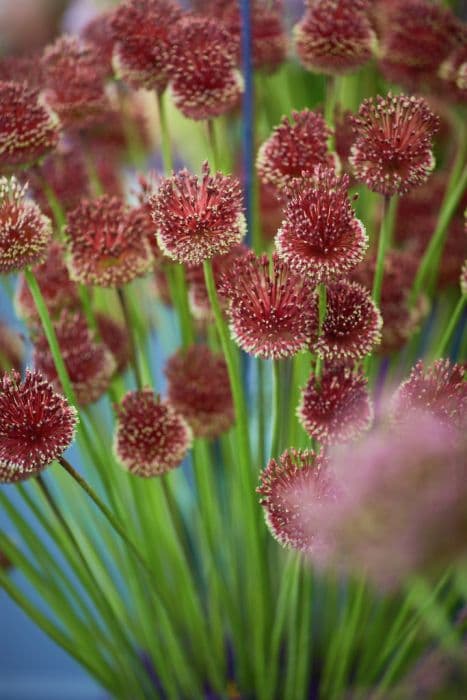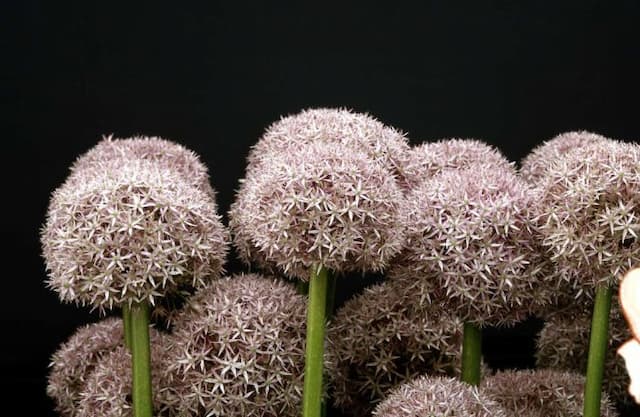Garlic chives Allium tuberosum











ABOUT
The plant commonly known as garlic chives is characterized by its long, slender, and flat leaves that are bright green in color. These leaves are hollow and grow in clumps, resembling the common chives, but with a distinct garlic flavor when tasted. The plant produces flower stems that are topped with clusters of star-shaped flowers. These flowers are typically white and form an umbrella-like shape at the top of the stem, making an attractive display. The visual appeal of garlic chives is enhanced when the plant is in full bloom, as the white flowers contrast nicely with the green foliage.
About this plant
 Names
NamesSynonyms
Garlic Chives, Chinese Chives, Oriental Garlic, Asian Chives, Chinese Leek.
Common names
Allium ramosum, Allium odorum, Allium uliginosum, Nothoscordum sulcatum, Allium angulosum, Ophioscorodon ramosum, Allium amblyopetalum, Allium senescens.
 Toxicity
ToxicityTo humans
Allium tuberosum, commonly known as garlic chives, is not considered toxic to humans. In fact, it is used as a culinary herb in various dishes around the world. Its leaves, bulbs, and flowers are all edible when prepared properly. There are no well-documented cases of poisoning from consuming garlic chives in normal food amounts. However, as with any food, individual allergies or intolerances are possible, leading to symptoms like nausea, vomiting, or diarrhea in susceptible individuals.
To pets
Garlic chives (Allium tuberosum) can be toxic to pets such as cats and dogs if ingested in significant quantities. This plant belongs to the Allium family, which contains compounds that can be harmful to pets. Symptoms of poisoning include gastrointestinal upset, lethargy, abdominal pain, vomiting, diarrhea, elevated heart and respiratory rates, weakness, and in severe cases, damage to red blood cells leading to hemolytic anemia. Pet owners should prevent their animals from ingesting garlic chives to avoid these potential health risks.
 Characteristics
CharacteristicsLife cycle
Perennials
Foliage type
Deciduous
Color of leaves
Green
Flower color
White
Height
1-2 feet (30-60 cm)
Spread
0.5-1 feet (15-30 cm)
Plant type
Herb
Hardiness zones
4-9
Native area
Asia
Benefits
 General Benefits
General Benefits- Culinary Uses: Allium tuberosum, commonly known as garlic chives, imparts a mild garlic flavor to dishes and can be used in salads, soups, and stir-fries.
- Nutritional Value: Garlic chives are a source of vitamins A and C, calcium, and iron, contributing to a balanced diet.
- Horticultural Appeal: With its grass-like leaves and attractive white flowers, garlic chives can add beauty to gardens and landscapes.
- Pollinator Attraction: The flowers of garlic chives attract bees, butterflies, and other beneficial insects, supporting local ecosystems.
- Culinary Herb Companion: Garlic chives can be planted alongside other herbs in a kitchen garden for easy access to a variety of flavors.
- Easy to Grow: This hardy perennial is easy to cultivate and can grow in a variety of soil types, making it accessible for many gardeners.
- Edible Flowers: The white, star-shaped flowers of garlic chives are edible and can be used to garnish dishes, adding both flavor and visual appeal.
 Medical Properties
Medical Properties- Antimicrobial: Allium tuberosum may possess antimicrobial properties, which could be effective against certain bacteria and fungi.
- Antioxidant: The plant is known to contain antioxidants which are important for neutralizing harmful free radicals in the body.
- Anti-inflammatory: Some compounds in Allium tuberosum could help reduce inflammation and might be beneficial in managing inflammatory conditions.
- Cardiovascular health: The plant may contribute to cardiovascular health by potentially lowering blood lipids and improving circulation.
- Digestive aid: Traditional use suggests Allium tuberosum could aid in digestion and alleviate gastrointestinal issues.
- Immune system support: Consuming the plant might strengthen the immune system thanks to its potential vitamin and mineral content.
 Air-purifying Qualities
Air-purifying QualitiesThis plant is not specifically known for air purifying qualities.
 Other Uses
Other Uses- As a companion plant in gardens, garlic chives can help to deter pests such as aphids, which are repelled by the strong scent of the foliage.
- In floral arrangements, the starry white flowers of garlic chives add a delicate touch and have a mild fragrance that can be quite pleasant indoors.
- The dried flowers can be used in potpourri mixes, contributing a light aroma and adding texture to the blend.
- Gardeners may also use a decoction of the plant as a foliar spray to prevent fungal infections in other plants.
- Garlic chives are sometimes planted to prevent soil erosion due to their hardy nature and the dense mat of roots they develop.
- The seeds can be used as bird feed, particularly for those species that enjoy small, oil-rich seeds.
- This plant has been used as a natural insect repellent, with the leaves being rubbed on the skin to ward off mosquitoes and other biting insects.
- Garlic chive leaves are traditionally woven into garlands or wreaths for various cultural ceremonies or festivals in some countries.
- In craft projects, garlic chives can be used to create green dyes for fabrics when the leaves are processed adequately.
- Occasionally, garlic chives are used in fish tanks as a form of natural decoration and to provide a hiding spot for small species of aquarium fish.
Interesting Facts
 Feng Shui
Feng ShuiThe plant Garlic Chives is not used in Feng Shui practice.
 Zodiac Sign Compitability
Zodiac Sign CompitabilityThe plant Garlic Chives is not used in astrology practice.
 Plant Symbolism
Plant Symbolism- Perseverance: Due to its hardy nature, Allium tuberosum, commonly known as garlic chives, symbolizes the ability to withstand tough conditions and thrive.
- Longevity: Garlic chives are perennials that can grow for multiple years, which makes them a symbol of long life and endurance.
- Protection: In some cultures, alliums are believed to possess protective qualities, warding off evil spirits and bad luck. Garlic chives share this symbolism due to their strong aroma, which is thought to purify and protect.
- Health and Vitality: Known for their beneficial properties and nutrients, garlic chives represent good health and vitality.
- Culinary Enjoyment: Since garlic chives are commonly used in various cuisines, they exemplify the pleasures of cooking and gastronomic enjoyment.
 Water
WaterGarlic chives require regular watering, about once a week, ensuring that the soil remains moderately moist but not soggy. They thrive when given 1 inch of water per week, whether through rainfall or manual watering. Over-watering can lead to root rot, so it is crucial to allow the soil to dry out slightly between watering sessions. During the hotter seasons or in particularly dry climates, the frequency of watering may need to increase. However, it's important to adjust the watering schedule according to the weather conditions and the plant's growth phase; less water may be required during the dormant winter period.
 Light
LightGarlic chives prefer full sun to partial shade and will grow best when receiving at least six hours of direct sunlight daily. A spot that gets the bright morning sun with some afternoon shade can be ideal, especially in very hot climates. Good light is necessary for the plant to grow healthily and produce a good yield of its flavorful leaves.
 Temperature
TemperatureGarlic chives are hardy in a wide range of temperatures, withstanding cold down to around 15°F and heat up to around 90°F. The ideal temperature for growing garlic chives falls between 60°F and 70°F. As perennial plants, they can survive through winters, but growth will slow down or cease completely if the temperature drops below the survival threshold.
 Pruning
PruningPruning garlic chives involves cutting back the leaves to encourage thicker, more vigorous growth. It is best to prune them after they flower, cutting the spent flower heads to prevent unnecessary self-seeding. Pruning can be done periodically throughout the growing season as needed, to maintain plant shape and remove any yellowed or damaged leaves.
 Cleaning
CleaningNot needed
 Soil
SoilGarlic chives thrive in well-draining soil rich in organic matter. A mixture containing garden soil, compost, and some perlite or sand is ideal to ensure proper drainage and fertility. The ideal pH for garlic chives is between 6.0 and 7.0.
 Repotting
RepottingGarlic chives, being perennials, don't require frequent repotting. They should be repotted or divided every 3-4 years to avoid overcrowding and to rejuvenate the soil.
 Humidity & Misting
Humidity & MistingGarlic chives are not particularly demanding in terms of humidity; they do well in average outdoor humidity levels. There is no need to adjust the environment for humidity as long as the plant receives adequate water and sunlight.
 Suitable locations
Suitable locationsIndoor
Place garlic chives near a sunny window and water regularly.
Outdoor
Plant garlic chives in full sun and well-draining soil.
Hardiness zone
4-9 USDA
 Life cycle
Life cycleAllium tuberosum, commonly known as garlic chives, starts its life from seeds that germinate in soil with ample sunlight and good drainage, typically in the spring. The seedlings develop into clumps of grass-like leaves that are hollow and cylindrical, and the plant establishes a strong root system. As it matures, garlic chives produce upright flower stalks in late summer, which end in umbels of white, star-shaped flowers that are attractive to pollinators. After flowering, seeds form and are dispersed to start the next generation, or the plant can be propagated vegetatively by dividing clumps every few years. During the winter or in colder climates, garlic chives die back to the ground, only to regrow from their perennial rootstock when favorable conditions return. Garlic chives can also proliferate and become invasive if not managed, spreading through seed and by vegetative growth.
 Propogation
PropogationPropogation time
Late summer to early fall
The most popular method of propagating garlic chives, known scientifically as Allium tuberosum, is by division. This is typically done in the spring or early fall. During this time, the gardener will dig up an established clump of garlic chives and gently separate the cluster into smaller sections, each with a portion of the roots intact. These individual sections can then be replanted into well-drained soil, spaced approximately 8 to 12 inches (20 to 30 centimeters) apart to allow room for growth. Watering the new plantings thoroughly helps establish them. Division is effective for expanding the garden or renewing older plants that have become less vigorous. This method is favored for its simplicity and its quick results in terms of plant multiplication.









